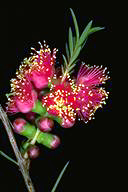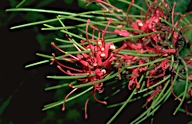

 |
Australian National Botanic Gardens
|
 |
A weekly news sheet prepared by a Gardens' volunteer.
Numbers in square brackets [] refer to garden bed Sections.
Plants in flower are in bold type.
23 September 2005
 |
|
Melaleuca 'Hot Pink' - click for larger image |
Today's walk is on the main path via the rainforest. Just outside the Visitor Information Centre on the left hand side is Acacia ‘Kuranga Cascade ' [Section 212]. It is prostrate with heart shaped foliage and lots of little yellow flowering balls sprawling over the rocks. Next door is Philotheca ‘Profusion '[Section 212], a compact shrub which has white flowers with five petals and scented leaves.
Turn left following the main path. On the corner is Epacris impressa ‘ Cranbourne Bells ' [Section 212]. This small plant has delightful white bells running up and down the stem. The leaves are tiny and sharp. Acacia acinacea [Section 212] is a small shrub with small mid-green leaves and sprays of yellow flower balls. Melaleuca ‘ Hot Pink ' [Section 212] is a tall, spindly shrub with bright pink bottlebrush flower heads with narrow leaves. Listen to the waterfall and the birds in the background. The waterfall is lined with palms Cordyline obtecta [Section 210]. Note the beautiful bamboo-like grass growing in front, Austrostipa ramosissima.
 |
Hakea purpurea - click for larger image |
Continuing along the main path crossing the boardwalk through the rainforest, the trees are tall and straight, with tree ferns down below like umbrellas. Gentle sunlight filters through the trees. Leaving the rainforest, cross the road, and on the right is Persoonia pinifolia [Section 110], a small tree which has lots of green fruits on it. Next door is the famous pine, Wollemia noblis [Section 110]. Opposite the Rockery is Thomasia sp. [Section 4], a small bush of pink drooping flowers with black centres and light green soft leaves. To the left is Dampiera rosmarinifolia [Section 15]; a little herblike plant which has purple flowers. Approaching the lawn look at the background of flowering acacias; a Crimson Rosella adds a touch of red. Hakeas are in flower. Hakea recurva [Section 20] has creamy yellow clusters of spidery flowers in the axils of the long leathery leaves. Opposite is Hakea purpurea [Section 20], which has red spidery flowers and short leathery leaves.
Cross the road and wander through the acacias. Acacia decora [Section 18] is a low bush with large bright yellow balls, and the foliage is leaf-like. On the right is Acacia cognata [Section 19], a very graceful tree with light yellow flowers, weeping foliage. Acacia phasmoides [Section 18], an endangered species, has yellow balls which spiral up the stem; foliage long and wavy. Acacia fimbriata [Section 18] is a low spreading tree that curls and weaves close to the ground. It has bunches of yellow flowers. Wander through the Eucalypt Lawn to the Sydney Region Gully. Hibbertia linearis [Section 191L] is a little plant with yellow flowers, and leaves rotating around the stems. Grevillea aspleniifolia [Section 191L] is a large spreading toothbrush shrub; a honeyeater is taking its fill. The flowers are pink. Nearby is a bigger hibbertia flower, Hibbertia saligna [Section 191L].
More to see…
Lesley Page